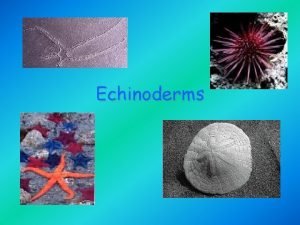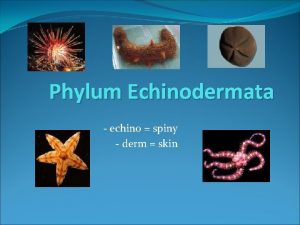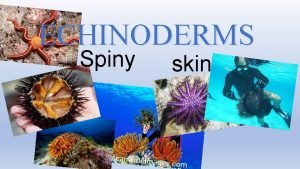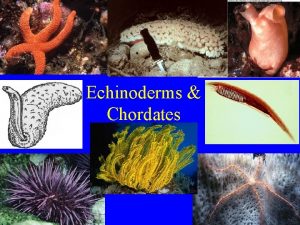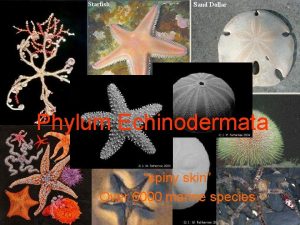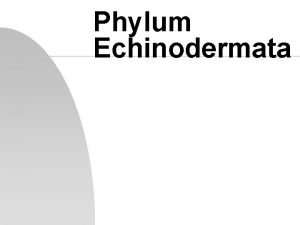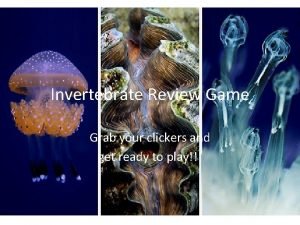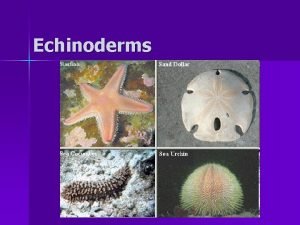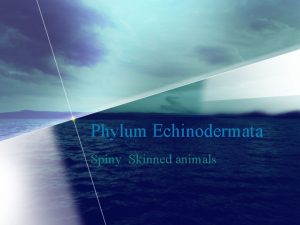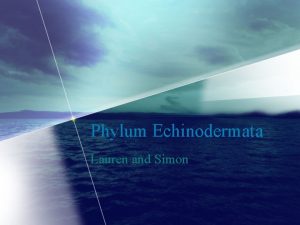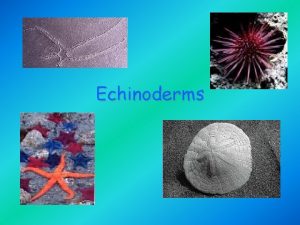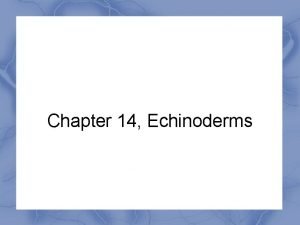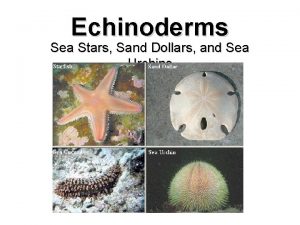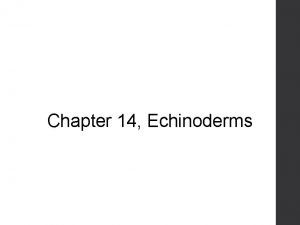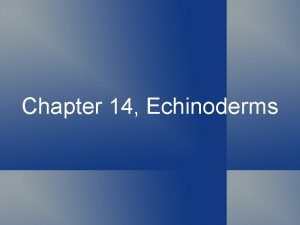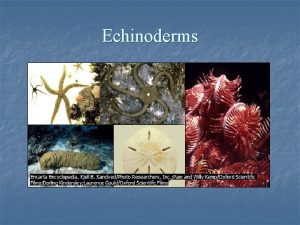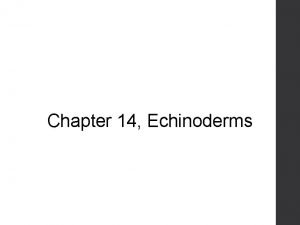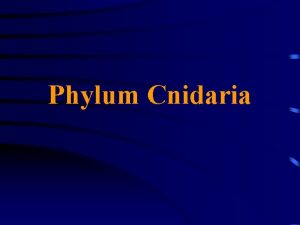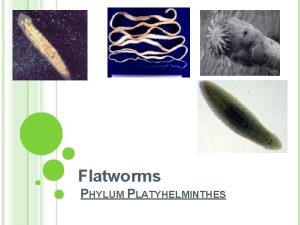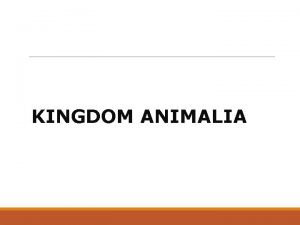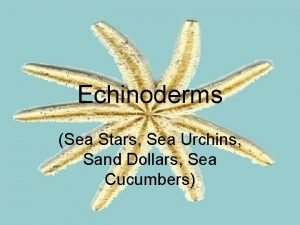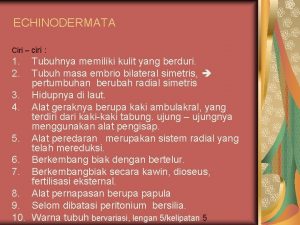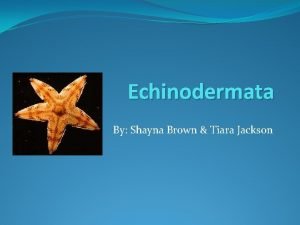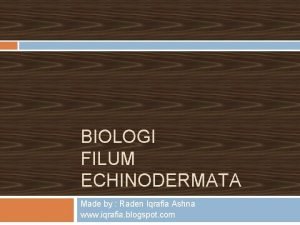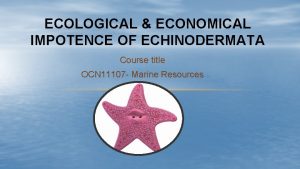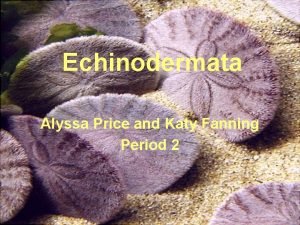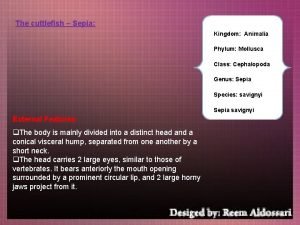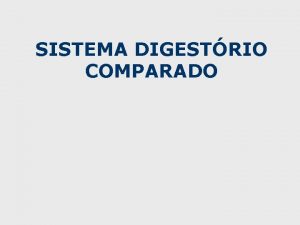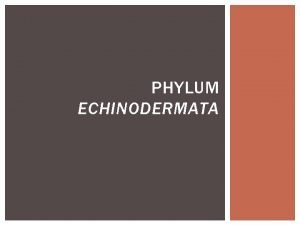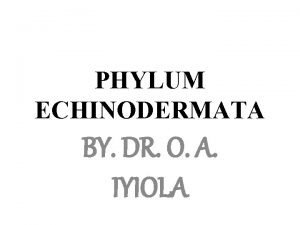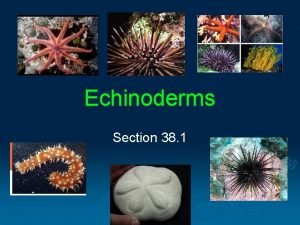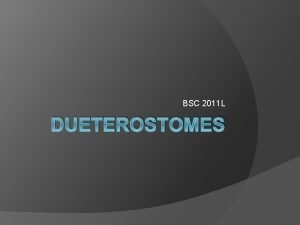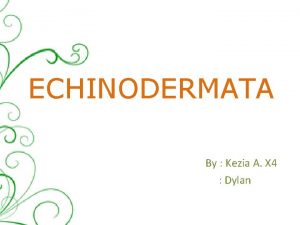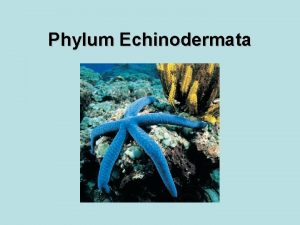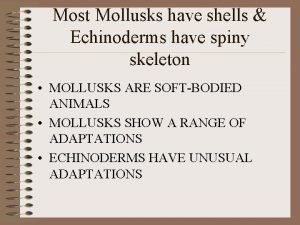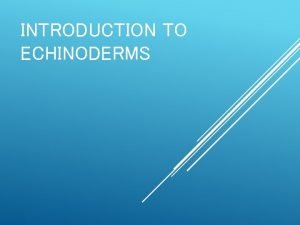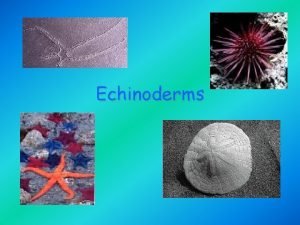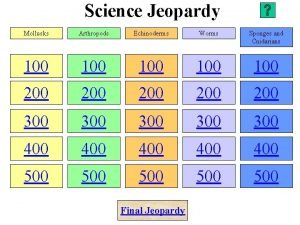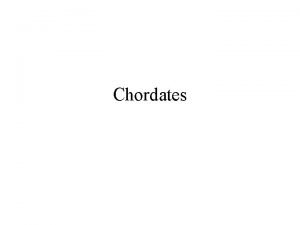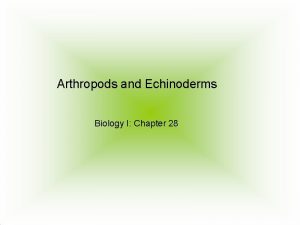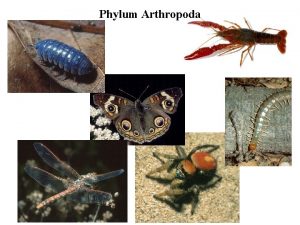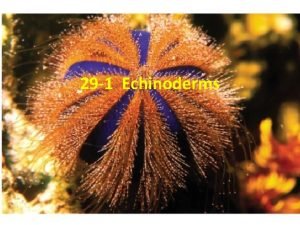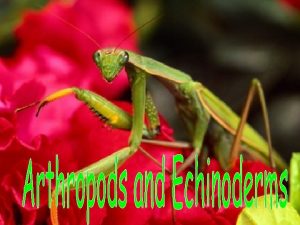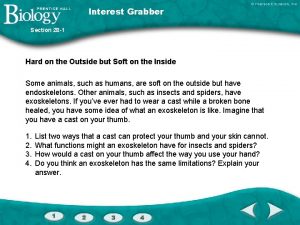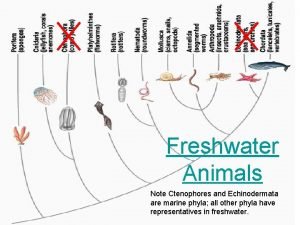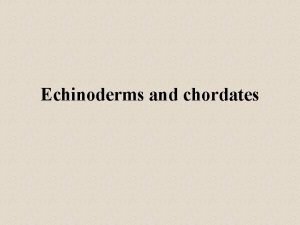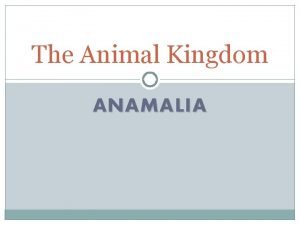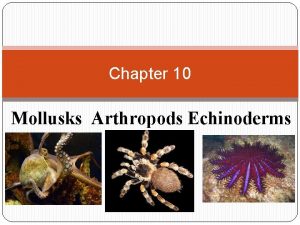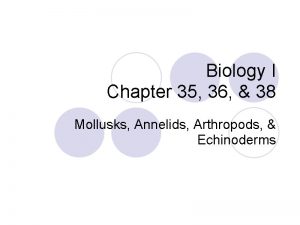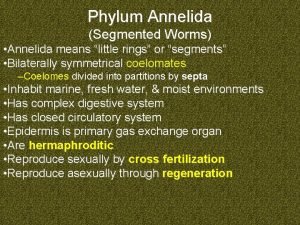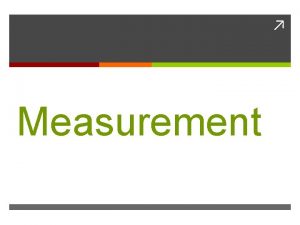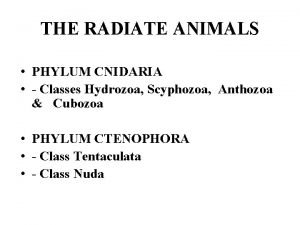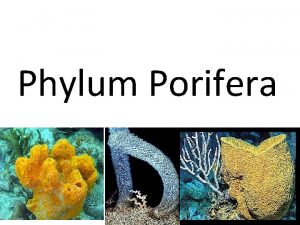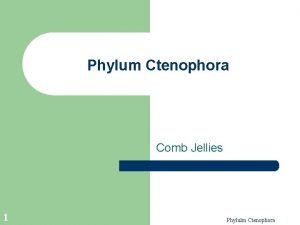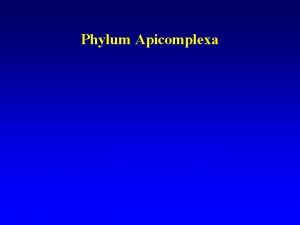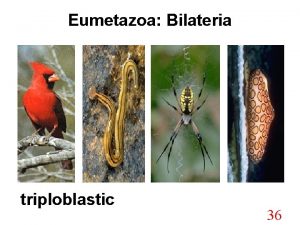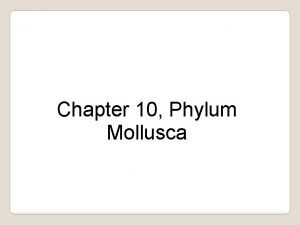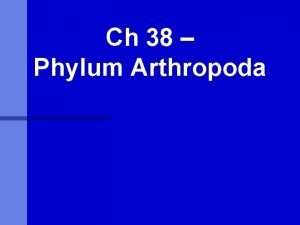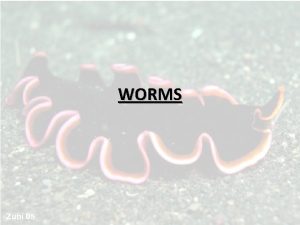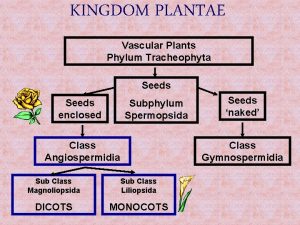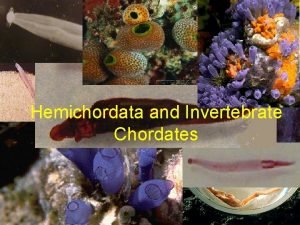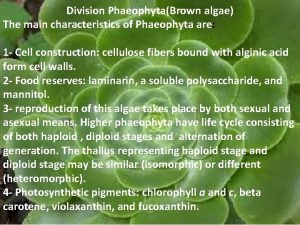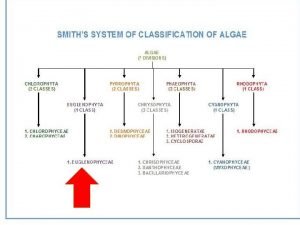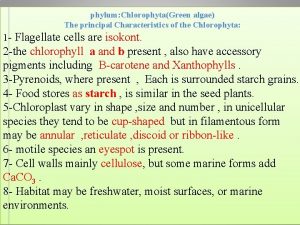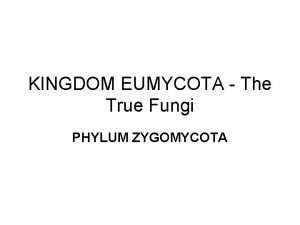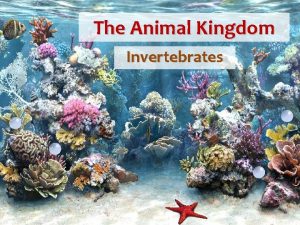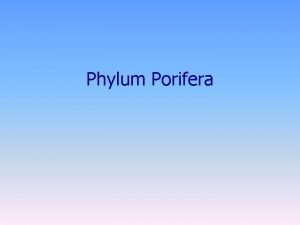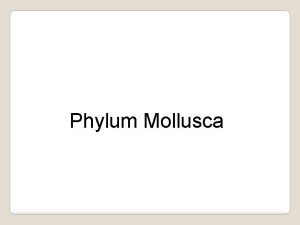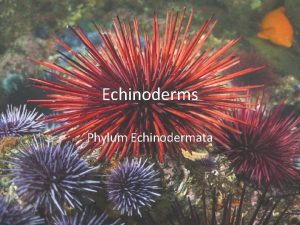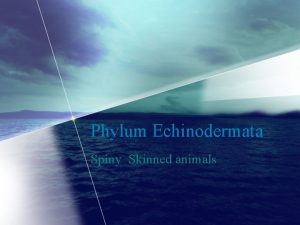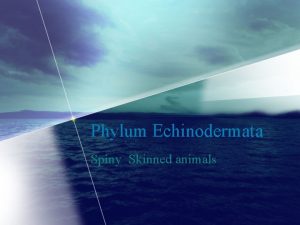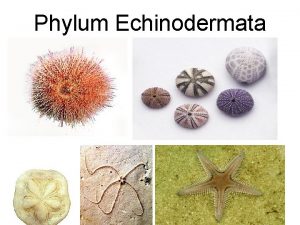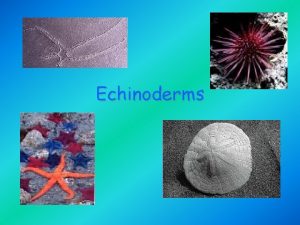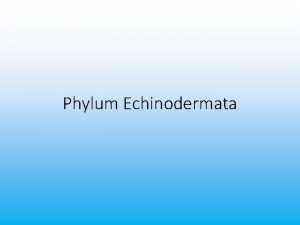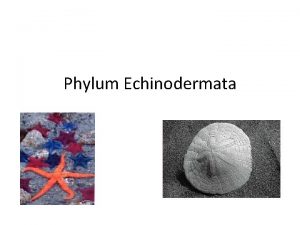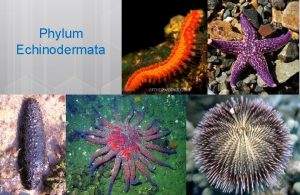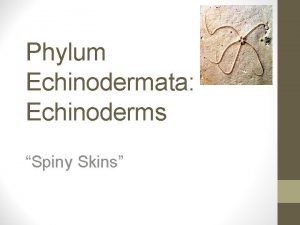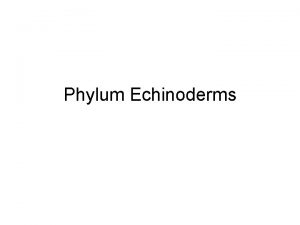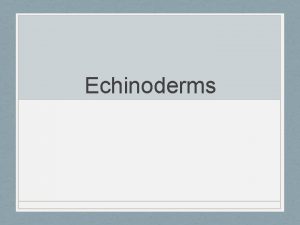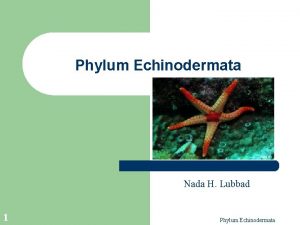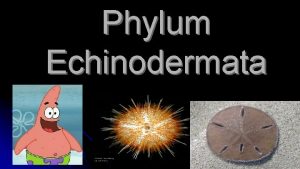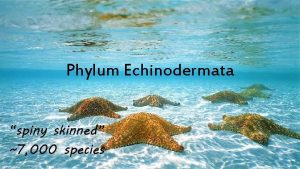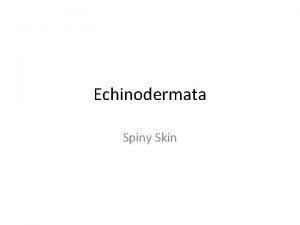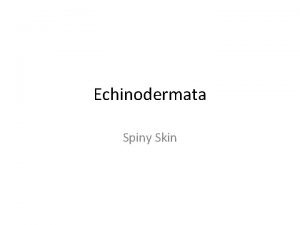Phylum Echinodermata The Echinoderms General Characteristics Means spiny














































































- Slides: 78

Phylum Echinodermata The Echinoderms

General Characteristics • Means “spiny skin” • Radially symmetrical • No sign cephalization –No concentration of sensory organs @ anterior end

I sure wish I could trade my spiney skin and radial symmetry for some cephalization

• Adults develop from bilaterally symmetrical larvae. –Suggests bilaterally symmetrical ancestors

Sea urchin






• All are deuterostomes (like chordates) –Anus forms from blastopore • Compare to prostomes –Mouth develops from blastopore


Hi. I’m a Blastula. This is my blastopore


• Most exhibit pentaradial symmetry –Body parts extend from center along five “spokes”

• Endoskeleton composed of calcium carbonate plates called ossicles –May be attached to spines or spicules protruding through skin



• Presence of watervascular system –Network of waterfilled canals inside body



• Tube feet are small movable extensions of the water vascular system –Aid in movement, feeding, respiration and excretion


Classification • 7000 species

• Six classes –Crinoidea –Ophiuroidea –Echinoidea –Holothuroidea –Asteroidea –concentricycloidea

Class Crinoidea • Members include sea lilies and feather stars • Members are called crinoids • Crinoid means “lily-like”

• Five arms extend from body to form up to 200 more arms • Tube feet filter organisms and detritus –Also aid in gas exchange

• Cilia transport food to mouth at base of arms • Mouth faces upward, unlike other echinoderms


Sea lilies • Most closely resemble echinoderm fossils • Sessile as adults • Attach via long stalk • Filter-feeder




Feather Stars • Can swim or crawl as adults





Class Ophiuroidea • Means “snake-tail” • Basket stars and brittle stars • Distinguished by long, narrow arms

• Arms allow for quickest movement of all echinoderms • Benthic • Feed by raking in food with arms or gathering with tube feet

Basket Stars • Arms branch repeatedly to form numerous coils • Arms resemble tentacles



Brittle Stars • So named because arms break off easily, then are regenerated





Class Echinoidea • Means “spinelike” • Sea urchins and sand dollars • Compact, rigid endoskeleton called a test

Sea Urchin • Tube feet used for locomotion • Feed by scraping algae with five teeth that surround mouth

• Jawlike structure of teeth and muscle called Aristotle’s lantern • Spines may be short and flat, long and thin, or wedge shaped

• Spines may be barbed or hollow and venom filled








Sand Dollars • Found in sandy neritic province • Shape is adaptation for shallow burrowing

• Short spines used for locomotion, burrowing, and to help clean itself • Tube feet capture plankton or detritus as it passes over or settles on their body




Class Holothuroidea • Means “water polyp” • Sea Cucumbers • Burrow into soft sediment

• Ossicles are small and unconnected • Tube feet surround mouth • Digests organic material found in sediment





Class Asteroidea • Means “starlike” • Sea stars or starfish • Live in coastal waters

• Economically important because is predator of bivalvia




Concentricycloidea • Sea daisies • discovered in 1986, have disk-shaped flat bodies and are less than 0. 39 in. (1 cm) in diameter. • The two known species were located on wood found in deep waters off the coasts of New Zealand the Bahamas.

• They have a water-vascular system, with tube feet on the body surface around the edge of the disk. • They have no obvious arms or mouth, and appear to absorb nutrients through the membrane surrounded their bodies.

 Spiny skin
Spiny skin Spiny plates phylum
Spiny plates phylum What is an echinoderm
What is an echinoderm Starfish
Starfish Phylum echinodermata
Phylum echinodermata Radial canal sea star
Radial canal sea star What phylum does squidward belong to
What phylum does squidward belong to Echinoderm facts
Echinoderm facts Marine animals with spiny skeleton
Marine animals with spiny skeleton Spiny plates phylum
Spiny plates phylum Spiny skin
Spiny skin Characteristics of echinoderms
Characteristics of echinoderms Spines in echinoderms
Spines in echinoderms Characteristics of echinoderms
Characteristics of echinoderms Dermal ossicles
Dermal ossicles Crinoidia
Crinoidia Echinodermscharacteristics
Echinodermscharacteristics Phylum cnidaria general characteristics
Phylum cnidaria general characteristics Aplacophora characteristics
Aplacophora characteristics Simplest bilateral animals
Simplest bilateral animals Cacing pita
Cacing pita Are sand dollars poisonous
Are sand dollars poisonous Ciri ciri echinodermata
Ciri ciri echinodermata Echinoderms cephalization
Echinoderms cephalization Contoh holothuroidea
Contoh holothuroidea Echinodermata
Echinodermata Germ layers of echinodermata
Germ layers of echinodermata Cuttlefish phylum
Cuttlefish phylum O'que sao repteis
O'que sao repteis Calcareous endoskeleton
Calcareous endoskeleton Holothuroidea
Holothuroidea Echinoderms
Echinoderms Echinodermata
Echinodermata Madreporit pada echinodermata
Madreporit pada echinodermata Sea star cephalization
Sea star cephalization Origami spiny lobster
Origami spiny lobster Mollusca skeletal system
Mollusca skeletal system Spiny skinned animals have an endoskeleton formed with
Spiny skinned animals have an endoskeleton formed with Where is a starfish mouth located
Where is a starfish mouth located Chapter 27 mollusks and segmented worms answer key
Chapter 27 mollusks and segmented worms answer key Garstang hypothesis
Garstang hypothesis Arthropods and echinoderms
Arthropods and echinoderms Body symmetry of echinoderms
Body symmetry of echinoderms Description of echinoderms
Description of echinoderms Have no backbone
Have no backbone Section 28-3 insects
Section 28-3 insects Freshwater echinoderms
Freshwater echinoderms Echinoderms and chordates
Echinoderms and chordates Are annelids cold blooded
Are annelids cold blooded Echinoderms
Echinoderms Oligocheta
Oligocheta This phylum name means “little rings”
This phylum name means “little rings” What phylum means jointed foot
What phylum means jointed foot Segmentation of phylum porifera
Segmentation of phylum porifera Quadrilateral pentagon hexagon octagon
Quadrilateral pentagon hexagon octagon Metamorphic rocks
Metamorphic rocks Meta and morph means
Meta and morph means In situ conservation
In situ conservation Life bio
Life bio Scyphozoa characteristics
Scyphozoa characteristics Characteristics of ascon
Characteristics of ascon Ctenophora reproduction
Ctenophora reproduction Cnidarian digestive tract
Cnidarian digestive tract Meristomata
Meristomata General characteristics of apicomplexa
General characteristics of apicomplexa Eumatozoa
Eumatozoa Characteristics of phylum mollusca
Characteristics of phylum mollusca Arthropods characteristics
Arthropods characteristics Characteristics of platyhelminthes
Characteristics of platyhelminthes Characteristics of euglenophyta
Characteristics of euglenophyta Spermopsida plants
Spermopsida plants Invertebrate chordates characteristics
Invertebrate chordates characteristics Structure of phaeophyta
Structure of phaeophyta Characteristics of chrysophyta
Characteristics of chrysophyta Characteristics of algae
Characteristics of algae Zygomycota characteristics
Zygomycota characteristics Phylum platyhelminthes characteristics
Phylum platyhelminthes characteristics Porifera character
Porifera character Phylum mollusca characteristics
Phylum mollusca characteristics
